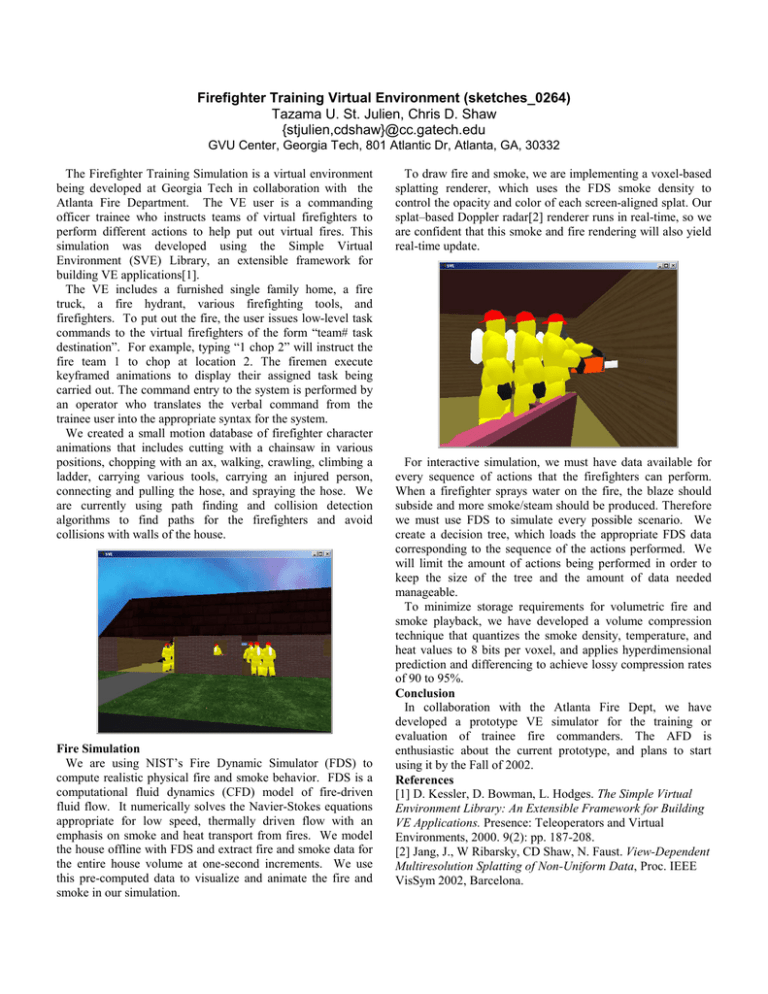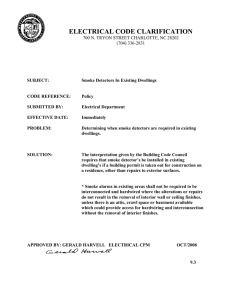Firefighter Training Virtual Environment (sketches_0264)
advertisement

Firefighter Training Virtual Environment (sketches_0264)
Tazama U. St. Julien, Chris D. Shaw
{stjulien,cdshaw}@cc.gatech.edu
GVU Center, Georgia Tech, 801 Atlantic Dr, Atlanta, GA, 30332
The Firefighter Training Simulation is a virtual environment
being developed at Georgia Tech in collaboration with the
Atlanta Fire Department. The VE user is a commanding
officer trainee who instructs teams of virtual firefighters to
perform different actions to help put out virtual fires. This
simulation was developed using the Simple Virtual
Environment (SVE) Library, an extensible framework for
building VE applications[1].
The VE includes a furnished single family home, a fire
truck, a fire hydrant, various firefighting tools, and
firefighters. To put out the fire, the user issues low-level task
commands to the virtual firefighters of the form “team# task
destination”. For example, typing “1 chop 2” will instruct the
fire team 1 to chop at location 2. The firemen execute
keyframed animations to display their assigned task being
carried out. The command entry to the system is performed by
an operator who translates the verbal command from the
trainee user into the appropriate syntax for the system.
We created a small motion database of firefighter character
animations that includes cutting with a chainsaw in various
positions, chopping with an ax, walking, crawling, climbing a
ladder, carrying various tools, carrying an injured person,
connecting and pulling the hose, and spraying the hose. We
are currently using path finding and collision detection
algorithms to find paths for the firefighters and avoid
collisions with walls of the house.
Fire Simulation
We are using NIST’s Fire Dynamic Simulator (FDS) to
compute realistic physical fire and smoke behavior. FDS is a
computational fluid dynamics (CFD) model of fire-driven
fluid flow. It numerically solves the Navier-Stokes equations
appropriate for low speed, thermally driven flow with an
emphasis on smoke and heat transport from fires. We model
the house offline with FDS and extract fire and smoke data for
the entire house volume at one-second increments. We use
this pre-computed data to visualize and animate the fire and
smoke in our simulation.
To draw fire and smoke, we are implementing a voxel-based
splatting renderer, which uses the FDS smoke density to
control the opacity and color of each screen-aligned splat. Our
splat–based Doppler radar[2] renderer runs in real-time, so we
are confident that this smoke and fire rendering will also yield
real-time update.
For interactive simulation, we must have data available for
every sequence of actions that the firefighters can perform.
When a firefighter sprays water on the fire, the blaze should
subside and more smoke/steam should be produced. Therefore
we must use FDS to simulate every possible scenario. We
create a decision tree, which loads the appropriate FDS data
corresponding to the sequence of the actions performed. We
will limit the amount of actions being performed in order to
keep the size of the tree and the amount of data needed
manageable.
To minimize storage requirements for volumetric fire and
smoke playback, we have developed a volume compression
technique that quantizes the smoke density, temperature, and
heat values to 8 bits per voxel, and applies hyperdimensional
prediction and differencing to achieve lossy compression rates
of 90 to 95%.
Conclusion
In collaboration with the Atlanta Fire Dept, we have
developed a prototype VE simulator for the training or
evaluation of trainee fire commanders. The AFD is
enthusiastic about the current prototype, and plans to start
using it by the Fall of 2002.
References
[1] D. Kessler, D. Bowman, L. Hodges. The Simple Virtual
Environment Library: An Extensible Framework for Building
VE Applications. Presence: Teleoperators and Virtual
Environments, 2000. 9(2): pp. 187-208.
[2] Jang, J., W Ribarsky, CD Shaw, N. Faust. View-Dependent
Multiresolution Splatting of Non-Uniform Data, Proc. IEEE
VisSym 2002, Barcelona.



